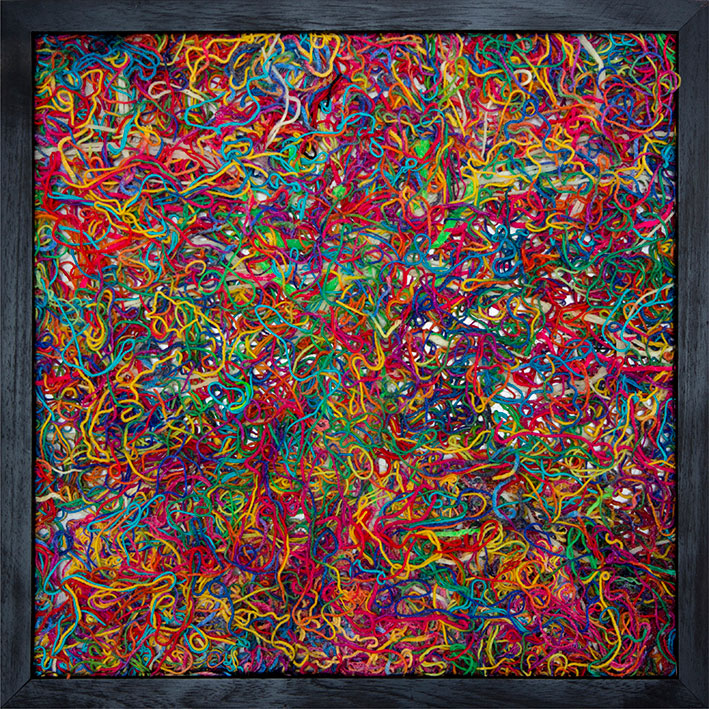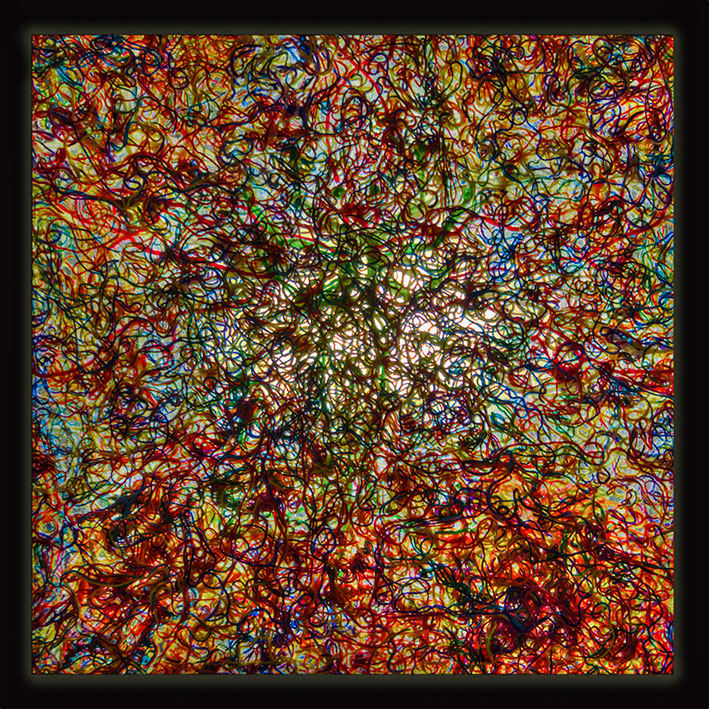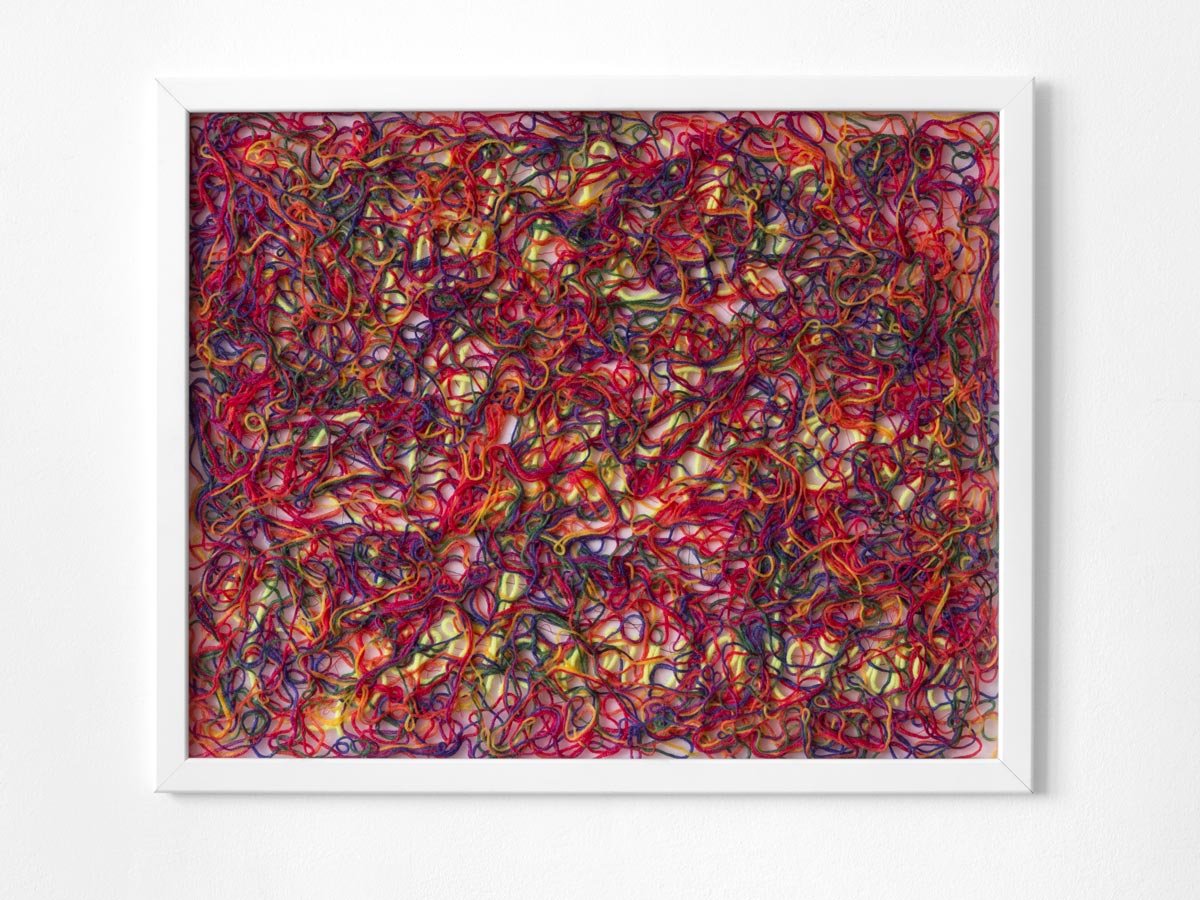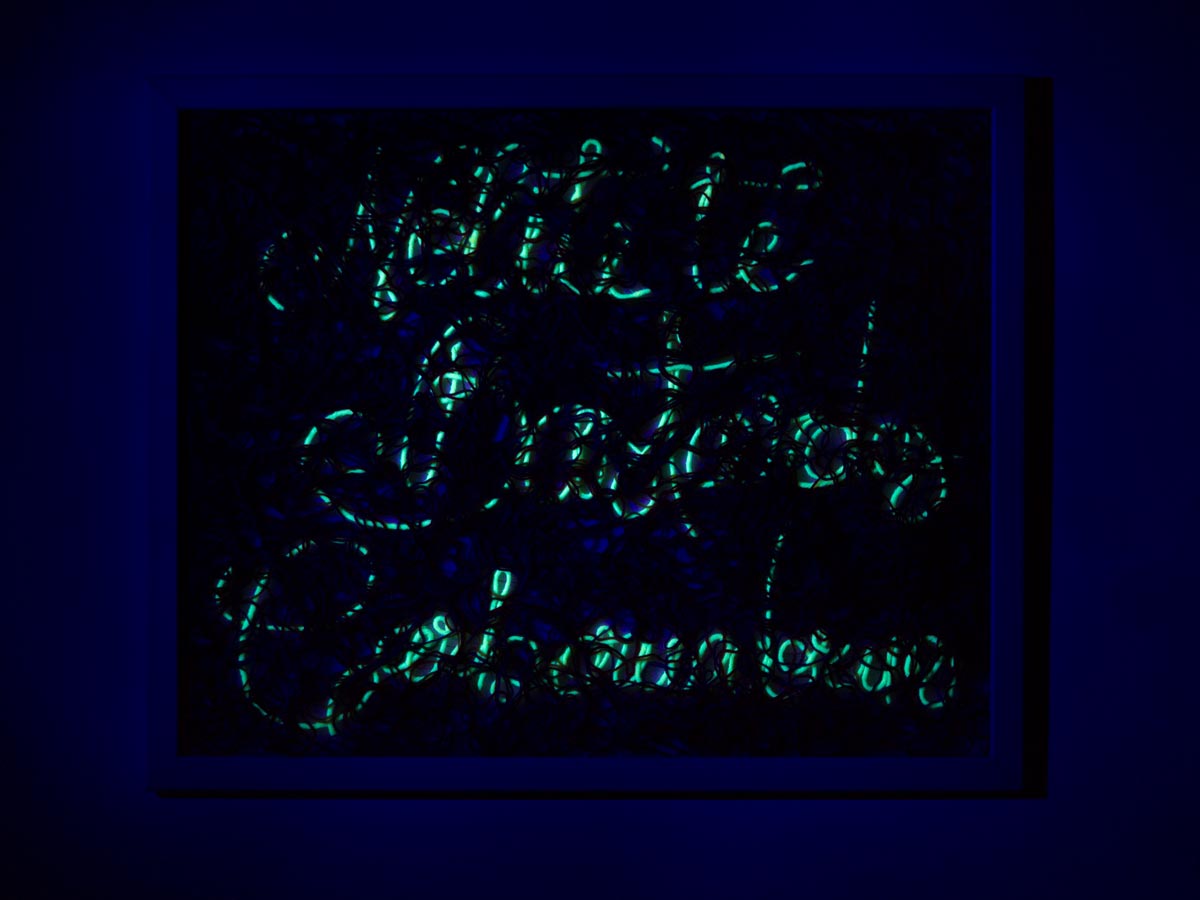The works in Superfici Variabili
(Variable Surfaces) balance between the visible and the invisible, between sensory experience and critical reflection. Through the use of filaments of various kinds, Eleonora Gugliotta constructs mutable surfaces that reveal their true meaning only under specific lighting conditions. The work is based on a perceptual tension: what appears as an abstract and decorative pattern transforms into a hidden message, accessible only to those willing to undertake an act of discovery.
La sperimentazione con la luce – frontale, retroilluminata o Wood – non è solo un espediente tecnico, ma un dispositivo concettuale che obbliga il fruitore a un atto di impegno. In un’epoca di consumo visivo rapido e superficiale, queste opere rifiutano la passività dello sguardo e impongono una riflessione: how much are we truly willing to see? The act of illuminating thus becomes a metaphor for a process of knowledge, an invitation to question the layers of reality, the unspoken, and the repressed.
The themes addressed—the fight against patriarchy, inner transformation, the necessity of encountering the other, resistance to social constructs—find their material transposition in the structure of the work itself. The invisible is not denied but hidden, ready to emerge under the right light. Art, like critical consciousness, cannot be grasped immediately: it requires attention, presence, an act of will.
The Superfici Variabili
(Variable Surfaces) are thus spaces of revelation, where the viewer measures their own capacity to see beyond appearance. An experience that does not end in visual perception but asks to be lived as a process of awareness and transformation. Superfici Variabili
(Variable Surfaces)
Visione Olometabolica (Holometabolic Vision), 2015
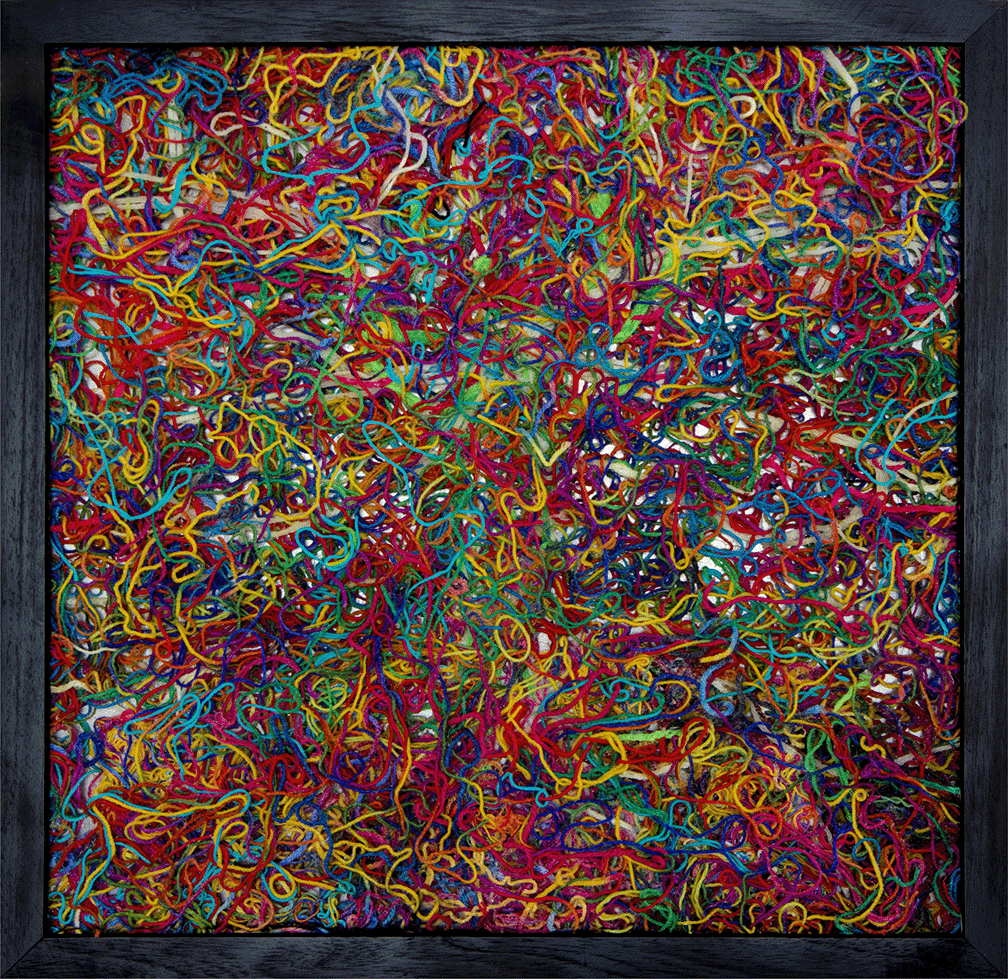
Visione Olometabolica (Holometabolic Vision), 2015
62 x 62 cm
(light change sensitive to movement)
"As our world is submerged in images, the habituation that has meanwhile arisen urges the artist to dare peculiar visual provocations, which will ultimately become the vehicle or bait through which the viewer, little by little, gains a certain confidence with the work and ends up exploring it, questioning it. This will undoubtedly favor the overcoming of the prevailing habituation, of this collective daze that translates the mass of images into a gray horizon."
Rolando Bellini
Visione Olometabolica (Holometabolic Vision), 2015 is a work that reveals itself only through interaction with the viewer. A sensor detects the approach and, at that precise moment, activates a lighting system that radically transforms the perception of the piece: previously invisible forms and details emerge, unveiling a new visual and conceptual dimension.
The chosen subject is a dragonfly, an insect belonging to the holometabolous family, whose complex evolutionary cycle inspired the performance Catarsi Crisadelica, 2016 -
(Chrysadelic Catharsis, 2016). Holometabolous insects undergo several metamorphic stages, and in particular, Lepidoptera—the winged insect family to which butterflies belong—experience a complete transformation, which becomes a metaphor for growth and inner rebirth. Like the butterfly, which must completely detach from its cocoon to evolve, humans can only achieve true awareness by freeing themselves from ties to the past.
This metamorphosis is a challenge: it means learning to see the world with new, clear, and objective eyes, without the burdens of childhood, inner insecurities, or the distortions imposed by a society dominated by appearance and conflict. Paradoxically, it is precisely this "pure" gaze that allows us to imagine new realities, to perceive invisible details, and to distinguish truth from pre-established schemes.
Nolite te Bastardes Carborundorum, 2020
Nolite te Bastardes Carborundorum is a work that powerfully engages in the debate on female resistance and the fight against patriarchy. The title, taken from Margaret Atwood’s renowned novel The Handmaid’s Tale , echoes a symbolic phrase carved into the darkness of a dystopian society—a clandestine message of rebellion left by one Handmaid for the next, like a thread of memory and resistance against violence and the subjugation imposed by power.
The artwork transforms this phrase into a perceptual and sensory experience, a message that reveals itself only to those willing to seek it. The inscription, invisible under ordinary lighting conditions, emerges through the use of Wood light, unveiling itself as a hidden yet indelible warning. This state of latency and revelation is not accidental—it mirrors the historical condition of women, forced to navigate the margins of a society that has always sought to silence them, to render them invisible. Yet, just like the carved message in the novel’s fiction, here too, the word resists, overcomes oblivion, and asserts itself as an active presence in space.
Nolite te Bastardes Carborundorum is an artwork of memory and struggle, a tribute to all the women who choose not to bow to imposed rules. Here, light becomes an act of resistance: what is hidden can be brought back into the light, what is meant to be erased can still be read.
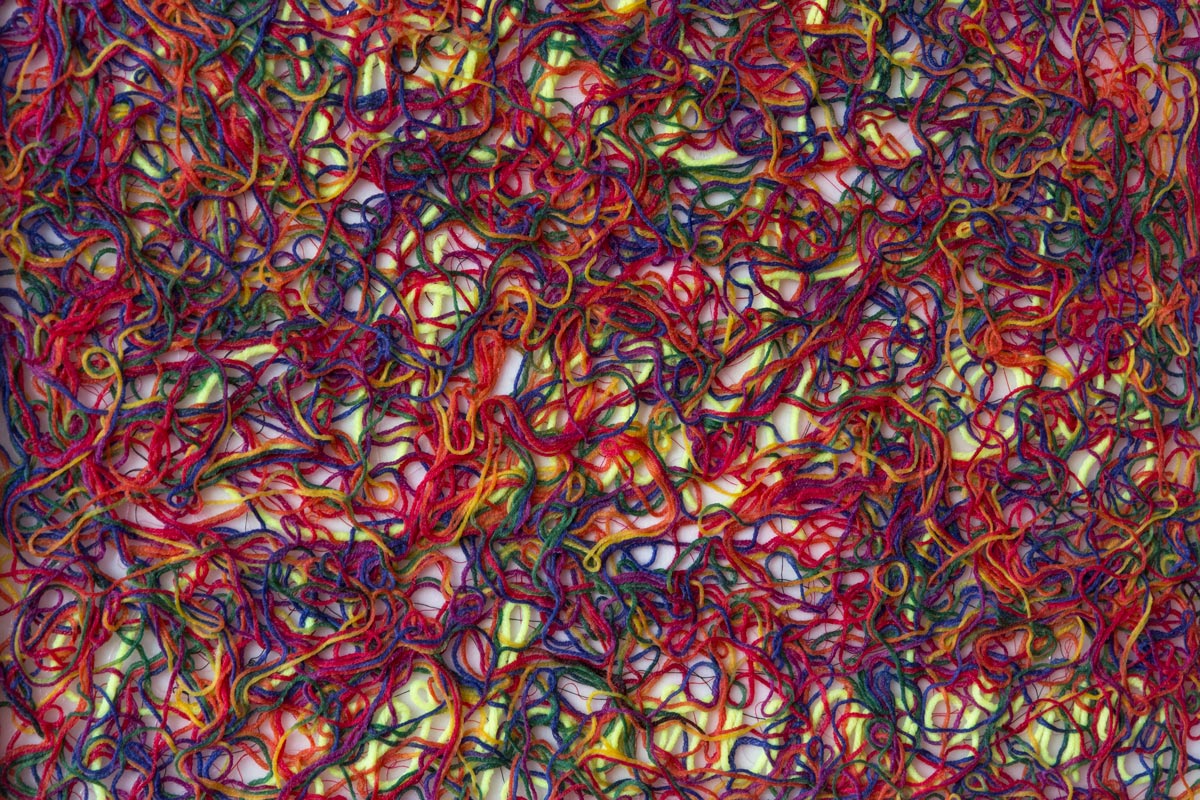
(Detail)
Incontro (MAAM) (Encounter (MAAM)), 2018
The artwork Incontro (MAAM) (Encounter (MAAM)) was created within the MAAM – Museo dell’Altro e dell’Altrove di Metropoliz in Rome, a unique space born from an occupation and transformed into a center for art and social research.
The piece is physically integrated into the heart of the community: the canteen counter, where the museum’s residents gather to share meals. Here, the word INCONTRO (ENCOUNTER) emerges as a key element, carrying a semantic ambivalence that perfectly reflects the reality of this space. An encounter is an act of coming together, of exchange and growth, but it can also be a clash, friction, confrontation. Just like the MAAM itself, which is both a refuge and a laboratory of contradictions—a place of hospitality but also of tension, inhabited by people who, every day, fight for the right to housing and human dignity.
INCONTRO (ENCOUNTER) becomes an invitation to reflect on the complexity of human relationships, on the possibility of transforming necessity into opportunity, and sharing into collective construction.

(Detail)
